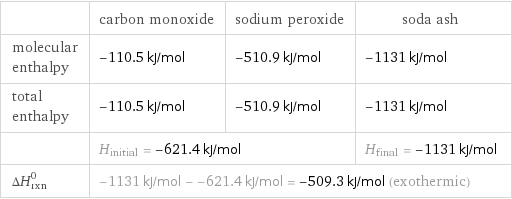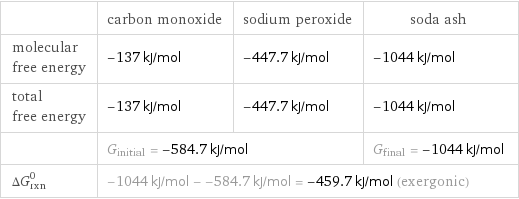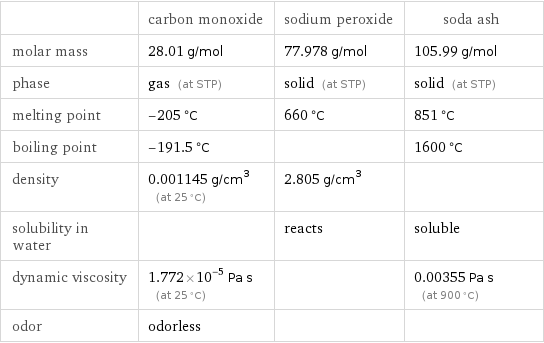Input interpretation

CO carbon monoxide + Na_2O_2 sodium peroxide ⟶ Na_2CO_3 soda ash
Balanced equation

Balance the chemical equation algebraically: CO + Na_2O_2 ⟶ Na_2CO_3 Add stoichiometric coefficients, c_i, to the reactants and products: c_1 CO + c_2 Na_2O_2 ⟶ c_3 Na_2CO_3 Set the number of atoms in the reactants equal to the number of atoms in the products for C, O and Na: C: | c_1 = c_3 O: | c_1 + 2 c_2 = 3 c_3 Na: | 2 c_2 = 2 c_3 Since the coefficients are relative quantities and underdetermined, choose a coefficient to set arbitrarily. To keep the coefficients small, the arbitrary value is ordinarily one. For instance, set c_1 = 1 and solve the system of equations for the remaining coefficients: c_1 = 1 c_2 = 1 c_3 = 1 Substitute the coefficients into the chemical reaction to obtain the balanced equation: Answer: | | CO + Na_2O_2 ⟶ Na_2CO_3
Structures

+ ⟶
Names

carbon monoxide + sodium peroxide ⟶ soda ash
Reaction thermodynamics
Enthalpy

| carbon monoxide | sodium peroxide | soda ash molecular enthalpy | -110.5 kJ/mol | -510.9 kJ/mol | -1131 kJ/mol total enthalpy | -110.5 kJ/mol | -510.9 kJ/mol | -1131 kJ/mol | H_initial = -621.4 kJ/mol | | H_final = -1131 kJ/mol ΔH_rxn^0 | -1131 kJ/mol - -621.4 kJ/mol = -509.3 kJ/mol (exothermic) | |
Gibbs free energy

| carbon monoxide | sodium peroxide | soda ash molecular free energy | -137 kJ/mol | -447.7 kJ/mol | -1044 kJ/mol total free energy | -137 kJ/mol | -447.7 kJ/mol | -1044 kJ/mol | G_initial = -584.7 kJ/mol | | G_final = -1044 kJ/mol ΔG_rxn^0 | -1044 kJ/mol - -584.7 kJ/mol = -459.7 kJ/mol (exergonic) | |
Entropy

| carbon monoxide | sodium peroxide | soda ash molecular entropy | 198 J/(mol K) | 95 J/(mol K) | 136 J/(mol K) total entropy | 198 J/(mol K) | 95 J/(mol K) | 136 J/(mol K) | S_initial = 293 J/(mol K) | | S_final = 136 J/(mol K) ΔS_rxn^0 | 136 J/(mol K) - 293 J/(mol K) = -157 J/(mol K) (exoentropic) | |
Equilibrium constant
![Construct the equilibrium constant, K, expression for: CO + Na_2O_2 ⟶ Na_2CO_3 Plan: • Balance the chemical equation. • Determine the stoichiometric numbers. • Assemble the activity expression for each chemical species. • Use the activity expressions to build the equilibrium constant expression. Write the balanced chemical equation: CO + Na_2O_2 ⟶ Na_2CO_3 Assign stoichiometric numbers, ν_i, using the stoichiometric coefficients, c_i, from the balanced chemical equation in the following manner: ν_i = -c_i for reactants and ν_i = c_i for products: chemical species | c_i | ν_i CO | 1 | -1 Na_2O_2 | 1 | -1 Na_2CO_3 | 1 | 1 Assemble the activity expressions accounting for the state of matter and ν_i: chemical species | c_i | ν_i | activity expression CO | 1 | -1 | ([CO])^(-1) Na_2O_2 | 1 | -1 | ([Na2O2])^(-1) Na_2CO_3 | 1 | 1 | [Na2CO3] The equilibrium constant symbol in the concentration basis is: K_c Mulitply the activity expressions to arrive at the K_c expression: Answer: | | K_c = ([CO])^(-1) ([Na2O2])^(-1) [Na2CO3] = ([Na2CO3])/([CO] [Na2O2])](../image_source/3f31b481a7c16a24ac0684d1531fb554.png)
Construct the equilibrium constant, K, expression for: CO + Na_2O_2 ⟶ Na_2CO_3 Plan: • Balance the chemical equation. • Determine the stoichiometric numbers. • Assemble the activity expression for each chemical species. • Use the activity expressions to build the equilibrium constant expression. Write the balanced chemical equation: CO + Na_2O_2 ⟶ Na_2CO_3 Assign stoichiometric numbers, ν_i, using the stoichiometric coefficients, c_i, from the balanced chemical equation in the following manner: ν_i = -c_i for reactants and ν_i = c_i for products: chemical species | c_i | ν_i CO | 1 | -1 Na_2O_2 | 1 | -1 Na_2CO_3 | 1 | 1 Assemble the activity expressions accounting for the state of matter and ν_i: chemical species | c_i | ν_i | activity expression CO | 1 | -1 | ([CO])^(-1) Na_2O_2 | 1 | -1 | ([Na2O2])^(-1) Na_2CO_3 | 1 | 1 | [Na2CO3] The equilibrium constant symbol in the concentration basis is: K_c Mulitply the activity expressions to arrive at the K_c expression: Answer: | | K_c = ([CO])^(-1) ([Na2O2])^(-1) [Na2CO3] = ([Na2CO3])/([CO] [Na2O2])
Rate of reaction
![Construct the rate of reaction expression for: CO + Na_2O_2 ⟶ Na_2CO_3 Plan: • Balance the chemical equation. • Determine the stoichiometric numbers. • Assemble the rate term for each chemical species. • Write the rate of reaction expression. Write the balanced chemical equation: CO + Na_2O_2 ⟶ Na_2CO_3 Assign stoichiometric numbers, ν_i, using the stoichiometric coefficients, c_i, from the balanced chemical equation in the following manner: ν_i = -c_i for reactants and ν_i = c_i for products: chemical species | c_i | ν_i CO | 1 | -1 Na_2O_2 | 1 | -1 Na_2CO_3 | 1 | 1 The rate term for each chemical species, B_i, is 1/ν_i(Δ[B_i])/(Δt) where [B_i] is the amount concentration and t is time: chemical species | c_i | ν_i | rate term CO | 1 | -1 | -(Δ[CO])/(Δt) Na_2O_2 | 1 | -1 | -(Δ[Na2O2])/(Δt) Na_2CO_3 | 1 | 1 | (Δ[Na2CO3])/(Δt) (for infinitesimal rate of change, replace Δ with d) Set the rate terms equal to each other to arrive at the rate expression: Answer: | | rate = -(Δ[CO])/(Δt) = -(Δ[Na2O2])/(Δt) = (Δ[Na2CO3])/(Δt) (assuming constant volume and no accumulation of intermediates or side products)](../image_source/f7e1bfe0196210290a4c3ccad4987a7e.png)
Construct the rate of reaction expression for: CO + Na_2O_2 ⟶ Na_2CO_3 Plan: • Balance the chemical equation. • Determine the stoichiometric numbers. • Assemble the rate term for each chemical species. • Write the rate of reaction expression. Write the balanced chemical equation: CO + Na_2O_2 ⟶ Na_2CO_3 Assign stoichiometric numbers, ν_i, using the stoichiometric coefficients, c_i, from the balanced chemical equation in the following manner: ν_i = -c_i for reactants and ν_i = c_i for products: chemical species | c_i | ν_i CO | 1 | -1 Na_2O_2 | 1 | -1 Na_2CO_3 | 1 | 1 The rate term for each chemical species, B_i, is 1/ν_i(Δ[B_i])/(Δt) where [B_i] is the amount concentration and t is time: chemical species | c_i | ν_i | rate term CO | 1 | -1 | -(Δ[CO])/(Δt) Na_2O_2 | 1 | -1 | -(Δ[Na2O2])/(Δt) Na_2CO_3 | 1 | 1 | (Δ[Na2CO3])/(Δt) (for infinitesimal rate of change, replace Δ with d) Set the rate terms equal to each other to arrive at the rate expression: Answer: | | rate = -(Δ[CO])/(Δt) = -(Δ[Na2O2])/(Δt) = (Δ[Na2CO3])/(Δt) (assuming constant volume and no accumulation of intermediates or side products)
Chemical names and formulas

| carbon monoxide | sodium peroxide | soda ash formula | CO | Na_2O_2 | Na_2CO_3 Hill formula | CO | Na_2O_2 | CNa_2O_3 name | carbon monoxide | sodium peroxide | soda ash IUPAC name | carbon monoxide | disodium peroxide | disodium carbonate
Substance properties

| carbon monoxide | sodium peroxide | soda ash molar mass | 28.01 g/mol | 77.978 g/mol | 105.99 g/mol phase | gas (at STP) | solid (at STP) | solid (at STP) melting point | -205 °C | 660 °C | 851 °C boiling point | -191.5 °C | | 1600 °C density | 0.001145 g/cm^3 (at 25 °C) | 2.805 g/cm^3 | solubility in water | | reacts | soluble dynamic viscosity | 1.772×10^-5 Pa s (at 25 °C) | | 0.00355 Pa s (at 900 °C) odor | odorless | |
Units
